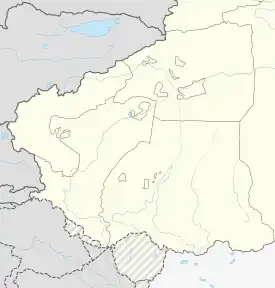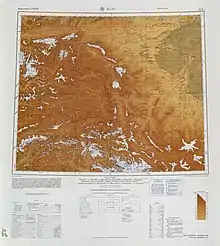Kiziloy
قىزىلئۆي يېزىسى 黑孜苇乡 Heiziwei | |
|---|---|
 Kiziloy Location of the township | |
| Coordinates: 39°42′26″N 75°12′52″E / 39.7073497883°N 75.2145409713°E | |
| Country | People's Republic of China |
| Autonomous region | Xinjiang |
| Prefecture | Kizilsu |
| County | Wuqia |
| Area | |
| • Total | 2,782 km2 (1,074 sq mi) |
| Elevation | 3,000 m (10,000 ft) |
| Population (2017) | |
| • Total | 6,899 |
| [2] | |
| Time zone | UTC+8 (China Standard Time) |
| Website | www |
Kiziloy[3][4] Township (قىزىلئۆي يېزىسى[5] / Heiziwei[6] Chinese: 黑孜苇乡[7]; pinyin: Hēizīwěi Xiāng) is the former county seat before 1989 and a township of Wuqia County in Xinjiang Uygur Autonomous Region, China. Located in the middle of the county, the township covers an area of 2,782.4 square kilometers with a population of 6,899 (as of 2017). It has 6 administrative villages under its jurisdiction. Its seat is at Kiziloy (黑孜苇).[2]
Kiziloy is located 5 kilometers away southwest of the county seat Wuqia Town. It is adjacent to Baykurut Township in the east, Shufu County in the south, Toyun Township in the northeast and Ulugqat Township in the northwest.[3]
Name
The name Kiziloy is from the Kyrgyz language and means "red depression" or "basin",[3] where 'kizil' ('heizi') means 'red' and 'oy' ('wei') means 'depression' or 'basin'. Other nearby places with the word 'kizil' (red) in their names include Kizilsu, Kizil Caves, and Kizilto.
On a Qing Dynasty map of Shufu County, the Kiziloy area is labeled Hezi'ayi (黑子阿依).[4]
History
Kiziloy was part of the 1st district in Wuqia County in 1950 and Kiziloy Commune (黑孜苇公社) was formed in 1958, it was renamed Dongfanghong Commune (东方红公社) in 1968 and restored the original name in 1980, and organized as a township in 1984.[3]
Overview

The township's seat is at 2,500 meters above sea level. The average elevation of the township is above 3,000 meters. The highest altitude is 4,000 meters. The altitude of each pasture point is 3000–4000 meters. More than 98% are Gobi desert and saline-alkali land. The local climate is extremely harsh, the winter is cold and long, the heating time is up to 6 months per year, and the lowest temperature in winter is as low as minus 6 degrees Celsius. The summer is cool and short, the highest temperature is about 25 degrees, there are many windy weather, frequent mountain flood disasters, and the annual average temperature is less than 6 °C. The terrain is cut in depth, the north is high and south low.
The width of east and west is 78 kilometers, and the north and south are 86 kilometers long. The total area of the township is 2,782.4 square kilometers, of which the grassland area is 1,693 square kilometers, the forest area is 120.13 hectares, and the cultivated area is 625.13 hectares. There are 6 villages and 25 village groups. There are a total of 2,604 households with a population of 6,899, of which, Kyrgyz of 5,201, Han of 1,067, Uyghur peoples of 5,90 and the other ethnic groups of 41.[2]
Settlements
The township has a residential community, 6 administration villages[2][8] and 16 unincorporated villages under its jurisdiction.[3][9]
1 community:
- Aybulak Community (Ayibulake; 阿依布拉克社区)
6 administration villages:
- Arabulak Village (Arebulake; 阿热布拉克村)
- Ekiterak Village (Yeketiereke, Yeketie Rekecun;[10] 也克铁热克村) 39°42′58″N 075°13′07″E / 39.71611°N 75.21861°E
- Jangir Village (Jiangji'er; 江吉尔村)
- Kanjgan Village (قانجۇغان كەنتى[11] / Kanjiugan, Kanjiugancun;[12] 坎久干村) 39°42′07″N 075°14′25″E / 39.70194°N 75.24028°E
- Kengxiwar Village (كەڭشىۋەر كەنت[5] / Kangshiwei'er, Kangshiwei'ercun;[13] 康什维尔村) 39°40′43″N 075°22′05″E / 39.67861°N 75.36806°E
- Kolerik Village (Kule'arike; 库勒阿日克村)
Demographics
| Year | Pop. | ±% p.a. |
|---|---|---|
| 2000 | 5,837 | — |
| 2010 | 5,405 | −0.77% |
| [14] | ||
As of 1997, the population of Kiziloy was 72.4% Kyrgyz.[9] The Heiziwei subgroup of Kyrgyz people speak the Heiziwei dialect of Northern Kyrgyz.[15]
Economy
Economic activities in Kiziloy include flour processing and other small scale industries as well as mining of celestine, gypsum, red clay, lead and zinc. Groundwater resources are abundant.[4]
Transportation
Notes
- ↑ From map: "DELINEATION OF INTERNATIONAL BOUNDARIES MUST NOT BE CONSIDERED AUTHORITATIVE"
References
- ↑ 乡镇频道. 乌恰县人民政府. Archived from the original on 17 May 2019.
- 1 2 3 4 黑孜苇乡. xjwqx.gov.cn. 2018-05-29. Archived from the original on 6 October 2020. Retrieved 2019-10-21 – via Google Cache, Internet Archive.
- 1 2 3 4 5 乌恰县行政区划和居民地名称 (in Simplified Chinese). xjwqx.gov.cn. 2018-06-04. Archived from the original on 8 October 2020. Retrieved 2019-10-21 – via Google Cache, Internet Archive.
- 1 2 3 Xie Yuzhong 解玉忠 (2003). 地名中的新疆 (in Simplified Chinese). Ürümqi: 新疆人民出版社. p. 195. ISBN 7-228-08004-1.
黑孜苇 Kiziloy
- 1 2 古丽米娜 (ed.). يېشىللىققا پۈركەنگەن ئېكولوگىيە جاۋاب قەغىزى تاپشۇرۇش. ﺷﯩﻨﺠﺎﯓ ﻛﯘﺋﯧﻨﻠﯘﻥ ﺗﻮﺭﻯ 昆仑网 新疆党建网. Archived from the original on 27 July 2020 – via Internet Archive.
قىزىلئۆي يېزىسى كەڭشىۋەر كەنتىدە،
- ↑ Heiziwei (Approved - N) at GEOnet Names Server, United States National Geospatial-Intelligence Agency
- ↑ Pan Zhiping 潘志平, ed. (2003). 中亚的地缘政治文化 (in Simplified Chinese). Ürümqi: 新疆人民出版社. p. 345. ISBN 7-228-08315-6 – via Internet Archive.
黑孜苇
- ↑ 2018年乌恰县黑孜苇乡行政区划代码. National Bureau of Statistics of China. 2018-10-31. Retrieved 2019-10-21.
- 1 2 1997年乌恰县行政区划 [1997 Ulugqat County Administrative Divisions] (in Simplified Chinese). XZQH.org. 31 December 2010. Archived from the original on 15 October 2017. Retrieved 5 October 2020.
黑孜苇乡 位于县城南3.5千米。面积2782.4平方千米,人口0.5万,其中柯尔克孜族占72.4%,辖库勒阿日克、也克铁热克、阿热布拉克、康西湾4个行政村。"黑孜苇"系柯尔克孜语译音,意为"红色的洼地"。1950年设黑孜苇乡,1958年建公社,1969年更名东方红公社,1984年复改黑孜苇乡。康苏河和库孜洪河流经乡境。
- ↑ Yeketie Rekecun (Approved - N) at GEOnet Names Server, United States National Geospatial-Intelligence Agency
- ↑ شىنجاڭغا نىشانلىق ياردەم بېرىش: تولار زېمىن باھار پەيزىگە، بارچە گۈللەر ئاچقاندا پورەك. People's Daily. 17 June 2019. Archived from the original on 9 August 2020. Retrieved 6 October 2020.
قىزىلئۆي يېزىسى قانجۇغان كەنتى
- ↑ Kanjiugancun (Approved - N) at GEOnet Names Server, United States National Geospatial-Intelligence Agency
- ↑ Kangshiwei’ercun (Approved - N) at GEOnet Names Server, United States National Geospatial-Intelligence Agency
- ↑ 乌恰县历史沿革. XZQH.org (in Simplified Chinese). 29 January 2015. Archived from the original on 15 October 2017. Retrieved 5 October 2020.
2000年第五次人口普查,乌恰县常住总人口42002人,其中:{...}黑孜苇乡5837人、{...}2010年第六次人口普查,乌恰县常住总人口47261人,其中:{...}黑孜韦乡5405人,{...
} - ↑ James S. Olson (1988). An Ethnohistorical Dictionary of China (PDF). Greenwood Press. pp. 140, 180, 261. Archived (PDF) from the original on 11 July 2020.
External links
- 新疆乌恰县黑孜苇乡柯尔克孜族宗教信仰调查 (Kirghiz Religious Belief Investigation in Kiziloy Township, Ulugqat County, Xinjiang) in journal Xiyu Yanjiu (西域研究) (2004) (in Chinese)